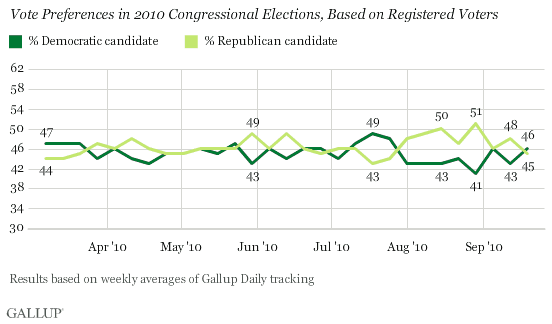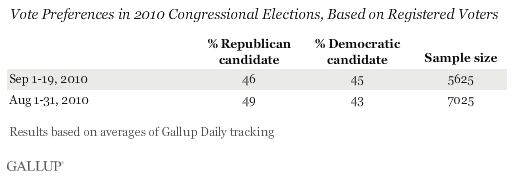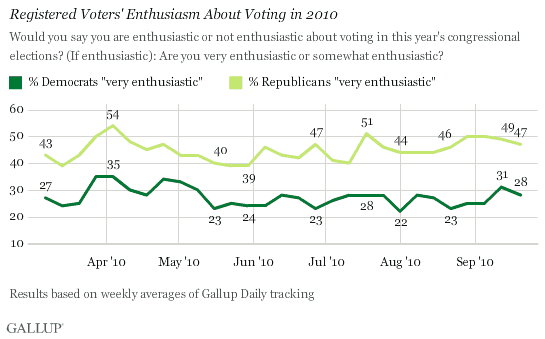PRINCETON, NJ -- Gallup's generic ballot for Congress for the week of Sept. 13-19 shows a 46% Democratic and 45% Republican split in registered voters' preferences for the midterm congressional elections. It is the second week out of the last three in which the two parties have been virtually tied.

Gallup's tracking shows a shift from a 49% to 43% Republican advantage in August to a 46% to 45% GOP advantage so far in September. Both of these estimates are based on very large samples, with more than 7,000 interviews conducted in August and more than 5,600 so far in September.

Regardless of these modest shifts in voting intentions, Republicans remain significantly more likely than Democrats to say they are "very" enthusiastic about voting in this year's midterm elections.

The enthusiasm gap this past week was 19 percentage points, with 47% of Republicans very enthusiastic about voting, compared with 28% of Democrats. Republicans have enjoyed at least a 10-point advantage on this measure since Gallup began tracking congressional election preferences in March, including margins of 16 points or higher since August.
Given this continuing enthusiasm gap between Republicans and Democrats, even a tie in registered voters' preferences will almost certainly mean the Republicans will garner the most votes on Election Day.
Bottom Line
Republicans have so far this month lost a little of the unprecedented strength they had among registered voters in August. Voting intentions among registered voters from Sept. 1-19 show a virtual tie between Republicans and Democrats, which is down from the six-point Republican advantage in August. Gallup will begin estimating the voting preferences of the probable 2010 electorate in October, which is highly likely to show a larger Republican advantage than is seen among registered voters.
The pace of midterm congressional election campaigning is beginning to pick up, both at the individual district level, and in terms of national news emphasis. Last week's primary elections, for example, focused news attention on the potential impact of more conservative, Tea Party-backed Republican candidates on the general election. It is possible that further shifts in voter sentiment will be seen in the weeks ahead.
Survey Methods
Results are based on telephone interviews conducted as part of Gallup Daily tracking Sept. 13-19, 2010, with a random sample of 2,925 registered voters, aged 18 and older, living in all 50 U.S. states and the District of Columbia, selected using random-digit-dial sampling.
For results based on the total sample of registered voters, one can say with 95% confidence that the maximum margin of sampling error is ±2 percentage points.
Interviews are conducted with respondents on landline telephones and cellular phones, with interviews conducted in Spanish for respondents who are primarily Spanish-speaking. Each daily sample includes a minimum quota of 150 cell phone respondents and 850 landline respondents, with additional minimum quotas among landline respondents for gender within region. Landline respondents are chosen at random within each household on the basis of which member had the most recent birthday.
Samples are weighted by gender, age, race, Hispanic ethnicity, education, region, adults in the household, cell phone-only status, cell phone-mostly status, and phone lines. Demographic weighting targets are based on the March 2009 Current Population Survey figures for the aged 18 and older non-institutionalized population living in U.S. telephone households. All reported margins of sampling error include the computed design effects for weighting and sample design.
In addition to sampling error, question wording and practical difficulties in conducting surveys can introduce error or bias into the findings of public opinion polls.
For more details on Gallup's polling methodology, visit https://www.gallup.com/.
